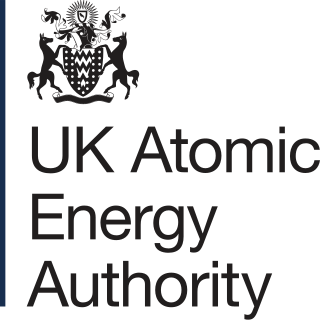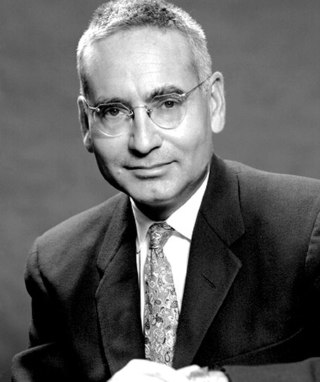
Argonne National Laboratory is a federally funded research and development center in Lemont, Illinois, United States. Founded in 1946, the laboratory is owned by the United States Department of Energy and administered by UChicago Argonne LLC of the University of Chicago. The facility is the largest national laboratory in the Midwest.

A breeder reactor is a nuclear reactor that generates more fissile material than it consumes. These reactors can be fuelled with more commonly available isotopes of uranium and thorium, such as uranium-238 or thorium-232, as opposed to the rare uranium-235 which is used in conventional reactors. These materials are called fertile materials since they can be bred into fuel by these breeder reactors.

The Atomic Energy Research Establishment (AERE) was the main centre for atomic energy research and development in the United Kingdom from 1946 to the 1990s. It was created, owned and funded by the British Government.

Cyril Stanley Smith was a British metallurgist and historian of science. He is most famous for his work on the Manhattan Project where he was responsible for the production of fissionable metals. A graduate of the University of Birmingham and Massachusetts Institute of Technology (MIT), Smith worked for many years as a research metallurgist at the American Brass Company. During World War II he worked in the Chemical-Metallurgical Division of the Los Alamos Laboratory, where he purified, cast and shaped uranium-235 and plutonium, a metal hitherto available only in microgram amounts, and whose properties were largely unknown. After the war he served on the Atomic Energy Commission's influential General Advisory Committee, and the President's Science Advisory Committee.

The United Kingdom Atomic Energy Authority is a UK government research organisation responsible for the development of fusion energy. It is an executive non-departmental public body of the Department for Energy Security and Net Zero (DESNZ).

Dounreay is a small settlement and the site of two large nuclear establishments on the north coast of Caithness in the Highland area of Scotland. It is on the A836 road nine miles west of Thurso.
Ames National Laboratory, formerly Ames Laboratory, is a United States Department of Energy national laboratory located in Ames, Iowa, and affiliated with Iowa State University. It is a top-level national laboratory for research on national security, energy, and the environment. The laboratory conducts research into areas of national concern, including the synthesis and study of new materials, energy resources, high-speed computer design, and environmental cleanup and restoration. It is located on the campus of Iowa State University.

A molten salt reactor (MSR) is a class of nuclear fission reactor in which the primary nuclear reactor coolant and/or the fuel is a mixture of molten salt with a fissionable material.

The Metallurgical Laboratory was a scientific laboratory at the University of Chicago that was established in February 1942 to study and use the newly discovered chemical element plutonium. It researched plutonium's chemistry and metallurgy, designed the world's first nuclear reactors to produce it, and developed chemical processes to separate it from other elements. In August 1942 the lab's chemical section was the first to chemically separate a weighable sample of plutonium, and on 2 December 1942, the Met Lab produced the first controlled nuclear chain reaction, in the reactor Chicago Pile-1, which was constructed under the stands of the university's old football stadium, Stagg Field.

The Bhabha Atomic Research Centre (BARC) is India's premier nuclear research facility, headquartered in Trombay, Mumbai, Maharashtra, India. It was founded by Homi Jehangir Bhabha as the Atomic Energy Establishment, Trombay (AEET) in January 1954 as a multidisciplinary research program essential for India's nuclear program. It operates under the Department of Atomic Energy (DAE), which is directly overseen by the Prime Minister of India.

Indira Gandhi Centre for Atomic Research(IGCAR) is one of India's premier nuclear research centres. It is the second largest establishment of the Department of Atomic Energy (DAE), next to Bhabha Atomic Research Centre (BARC), located at Kalpakkam, 80 km south of Chennai, India. It was established in 1971 as an exclusive centre dedicated to the pursuit of fast reactor science and technology, due to the vision of Dr. Vikram Sarabhai. Originally, it was called as Reactor Research Centre (RRC). It was renamed as Indira Gandhi Centre for Atomic Research(IGCAR) by the then Prime Minister of India, Rajiv Gandhi in December 1985. The centre is engaged in broad-based multidisciplinary programme of scientific research and advanced engineering directed towards the development of Fast Breeder Reactor technology, in India.

Samuel King Allison was an American physicist, most notable for his role in the Manhattan Project, for which he was awarded the Medal for Merit. He was director of the Metallurgical Laboratory from 1943 until 1944, and later worked at the Los Alamos Laboratory — where he "rode herd" on the final stages of the project as part of the "Cowpuncher Committee", and read the countdown for the detonation of the Trinity nuclear test. After the war, he returned to the University of Chicago to direct the Institute for Nuclear Studies and was involved in the "scientists' movement", lobbying for civilian control of nuclear weapons.
A liquid metal cooled nuclear reactor, or LMR is a type of nuclear reactor where the primary coolant is a liquid metal. Liquid metal cooled reactors were first adapted for breeder reactor power generation. They have also been used to power nuclear submarines.

Alvin Martin Weinberg was an American nuclear physicist who was the administrator of Oak Ridge National Laboratory (ORNL) during and after the Manhattan Project. He came to Oak Ridge, Tennessee, in 1945 and remained there until his death in 2006. He was the first to use the term "Faustian bargain" to describe nuclear energy.

Winfrith Atomic Energy Establishment, or AEE Winfrith, was a United Kingdom Atomic Energy Authority site near Winfrith Newburgh in Dorset. It covered an area on Winfrith Heath to the west of the village of Wool between the A352 road and the South West Main Line.

Walter Henry Zinn was a Canadian-born American nuclear physicist who was the first director of the Argonne National Laboratory from 1946 to 1956. He worked at the Manhattan Project's Metallurgical Laboratory during World War II, and supervised the construction of Chicago Pile-1, the world's first nuclear reactor, which went critical on December 2, 1942, at the University of Chicago. At Argonne he designed and built several new reactors, including Experimental Breeder Reactor I, the first nuclear reactor to produce electric power, which went live on December 20, 1951.
M. V. Ramana is professor and Simons Chair in Disarmament, Global and Human Security at the University of British Columbia, and Director of Liu Institute for Global Issues, at the School of Public Policy and Global Affairs. A physicist by training, he previously worked at the Nuclear Futures Laboratory and the Program on Science and Global Security, both at Princeton University. Ramana is a member of the International Panel on Fissile Materials, the Canadian Pugwash Group, the International Nuclear Risk Assessment Group, and the team that produces the annual World Nuclear Industry Status Report.

Edward Creutz was an American physicist who worked on the Manhattan Project at the Metallurgical Laboratory and the Los Alamos Laboratory during World War II. After the war he became a professor of physics at the Carnegie Institute of Technology. He was Vice President of Research at General Atomics from 1955 to 1970. He published over 65 papers on botany, physics, mathematics, metallurgy and science policy, and held 18 patents relating to nuclear energy.
Chaitanyamoy Ganguly is an Indian nuclear scientist and a former head of the Nuclear Fuel Cycle and Materials Section of the International Atomic Energy Agency (IAEA), credited with many innovations in the field of nuclear material science. He was honored by the government of India in 2002, with the fourth-highest Indian civilian award of Padma Shri.
Chokkanathapuram Venkataraman Sundaram (1929–2008) was an Indian chemical metallurgist, best known for the commissioning of the Fast Breeder Test Reactor at Kalpakkam. He was the director of the Indira Gandhi Centre for Atomic Research (IGCAR). He was a recipient of the Sanjay Gandhi Award for Science and Technology as well as the National Metallurgists Day Award and an elected fellow of the Indian National Science Academy, the Indian Academy of Sciences and the Indian National Academy of Engineering. The Government of India awarded him the Padma Bhushan, the third highest civilian award, in 1986.















